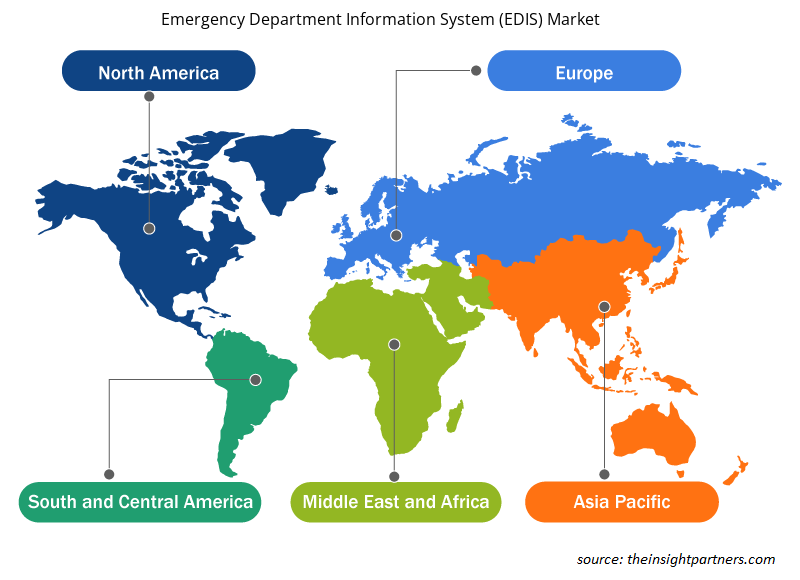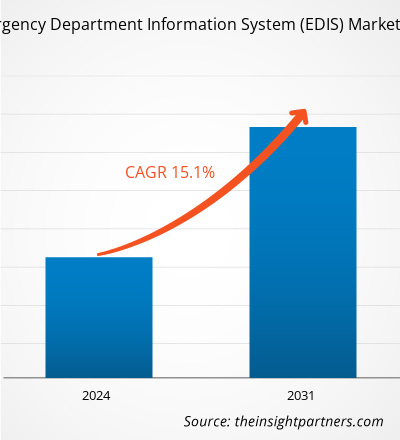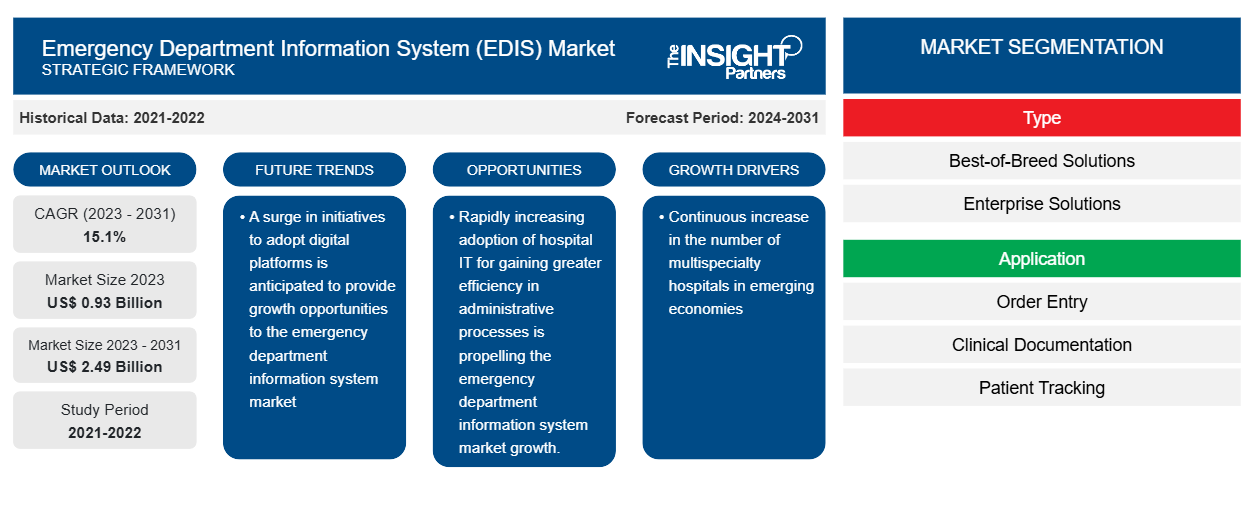Si prevede che la dimensione del mercato del sistema informativo del pronto soccorso (EDIS) raggiungerà i 2,49 miliardi di dollari entro il 2031, rispetto agli 0,93 miliardi di dollari del 2023. Si prevede che il mercato registrerà un CAGR del 15,10% nel periodo 2023-2031. L'emergere di servizi EDIS basati su cloud rimarrà probabilmente una tendenza chiave nel mercato.
Analisi di mercato del sistema informativo del pronto soccorso (EDIS)
I fattori chiave che stanno guidando la crescita del mercato sono un aumento del flusso di pazienti nei dipartimenti di emergenza e un alto tasso di adozione dei sistemi informativi dei dipartimenti di emergenza. Inoltre, i progressi nella digitalizzazione dei servizi sanitari offriranno probabilmente opportunità al mercato dei sistemi informativi dei dipartimenti di emergenza (EDIS) nei prossimi anni.
Panoramica del mercato del sistema informativo del pronto soccorso (EDIS)
I servizi medici di emergenza (EMS) riguardano la cura acuta dei pazienti. I reparti EMS gestiscono pazienti con complicazioni mediche, così come emergenze ostetriche e chirurgiche. Questi reparti curano anche ferite, infezioni, infarti , ictus, asma e complicazioni acute della gravidanza. Pertanto, si concentrano principalmente sulla cura di pazienti con ferite e malattie di emergenza, come ictus e arresto cardiaco. Anche i servizi richiesti in caso di calamità naturali sono inclusi nella categoria EMS. La domanda di servizi di cure di emergenza in ambito sanitario è in aumento a causa della crescente incidenza di arresti cardiaci e incidenti. Secondo l'European Resuscitation Council, l'incidenza segnalata di arresto cardiaco in Europa è di circa 67-170 ogni 100.000 individui. Secondo le stime fornite da stroke.org.uk, si prevede che il peso dell'ictus in Europa crescerà notevolmente nei prossimi anni. Le proiezioni in questo rapporto indicano che ci sarà un aumento del 34% nel numero totale di casi di ictus nell'Unione Europea nel periodo 2015-2035, poiché è probabile che il conteggio dei casi raggiunga quota 819.771 entro il 2035 da 613.148 nel 2015. Pertanto, si prevede che il flusso di pazienti nei pronto soccorso aumenterà nei prossimi anni.
Personalizza questo report in base alle tue esigenze
Riceverai la personalizzazione gratuita di qualsiasi report, comprese parti di questo report, o analisi a livello nazionale, pacchetto dati Excel, oltre a usufruire di grandi offerte e sconti per start-up e università
-
Scopri le principali tendenze di mercato in questo rapporto.Questo campione GRATUITO includerà analisi di dati che spaziano dalle tendenze di mercato alle stime e alle previsioni.
Driver e opportunità di mercato del sistema informativo del pronto soccorso (EDIS)
Elevata adozione dei sistemi informativi del pronto soccorso
I sistemi informativi del pronto soccorso (EDIS) migliorano l'utilizzo del personale sanitario e delle risorse, il che aiuta a gestire il flusso dei pazienti. I sistemi aiutano anche a migliorare il processo decisionale degli ospedali fornendo dati completi in tempo reale per le amministrazioni ospedaliere. Le soluzioni EDIS riducono i costi delle strutture sanitarie abbassando i costi di manodopera. Inoltre, la domanda di sistemi informativi del pronto soccorso è elevata in Nord America a causa dell'ampia accettazione della tecnologia in paesi come gli Stati Uniti e il Canada. Inoltre, il Nord America domina il mercato globale dei sistemi informativi del pronto soccorso, seguito dall'Europa. L'Europa è nota per la significativa crescita dell'adozione della trasformazione digitale dell'assistenza sanitaria telematica negli ambienti sanitari, insieme alla crescente spesa in infrastrutture sanitarie e alla disponibilità di dispositivi tecnologicamente avanzati. Oltre a ciò, la rapida crescita dell'adozione dell'IT ospedaliero per ottenere una maggiore efficienza nei processi amministrativi sta spingendo la crescita del mercato dei sistemi informativi del pronto soccorso.EDIS) improve healthcare staff and resource utilization, which helps manage patient flow. The systems also help enhance hospitals’ decision-making by providing comprehensive real-time data for hospital administrations. The EDIS solutions reduce the cost of healthcare facilities by lowering labor costs. Furthermore, the demand for emergency department information systems is high in North America due to the wide acceptance of technology in countries such as the US and Canada. Also, North America dominates the global emergency department information system market, followed by Europe. Europe is known for the significantly rising adoption of telematics healthcare digital transformation in healthcare settings, along with the growing expenditure in healthcare infrastructure and availability of technologically advanced devices. In addition to this, the rapidly increasing adoption of hospital IT to gain greater efficiency in administrative processes is propelling the growth of the emergency department information system market.
Progressi nella digitalizzazione dei servizi sanitariDigitalization of Healthcare Services
Negli ultimi anni, il processo di digitalizzazione dei servizi sanitari è aumentato con l'adozione dell'agenda eHealth agenda in vari paesi. L'eHealth può migliorare la qualità dei servizi e aiutare a migliorare l'accesso degli utenti alle informazioni sanitarie. Può anche aiutare i fornitori di servizi sanitari risparmiando tempo e riducendo il carico di lavoro e i costi associati a lungo termine. Telemedicina, cartelle cliniche elettroniche (EHR), prescrizioni online e sistemi di informazioni sanitarie sono tra le soluzioni digitali che possono essere utilizzate nell'implementazione dell'eHealth. La popolarità delle tecnologie digitali come le informazioni sanitarie protette (PHI) è aumentata notevolmente negli ultimi anni. Secondo i medici canadesi, la percentuale dei loro pazienti che utilizzano tecnologie digitali per gestire le proprie informazioni mediche è cresciuta dal 20,8% nel 2017 al 44,7% nel 2019.eHealth can enhance the quality of services and aid in improving users' access to health information. It can also help health service providers by saving time and reducing workload and associated costs in the long term. Telehealth, electronic health records (EHR), online prescriptions, and health information systems are among the digital solutions that can be used in the implementation of eHealth. The popularity of digital technologies such as protected health information (PHI) has increased considerably in recent years. According to Canadian physicians, the percentage of their patients using digital technologies to manage their medical information grew from 20.8% in 2017 to 44.7% by 2019.
Analisi della segmentazione del rapporto di mercato del sistema informativo del pronto soccorso (EDIS)EDIS) Market Report Segmentation Analysis
I segmenti chiave che hanno contribuito alla derivazione dell'analisi di mercato del sistema informativo del pronto soccorso (EDIS) sono tipologia, applicazione e utente finale.EDIS) market analysis are type, application, and end user.
- In base al tipo, il mercato del sistema informativo del pronto soccorso (EDIS) è segmentato in soluzioni best-of-breed e soluzioni aziendali. Il segmento dei kit di soluzioni best-of-breed ha detenuto la quota di mercato più significativa nel 2023.EDIS) market is segmented into best-of-breed solutions and enterprise solutions. The best-of-breed solutions kits segment held the most significant market share in 2023.
- In base all'applicazione, il mercato del sistema informativo del pronto soccorso (EDIS) è segmentato in base a immissione degli ordini, documentazione clinica, monitoraggio dei pazienti, prescrizione elettronica e altri. Il segmento di trattamento dell'immissione degli ordini ha detenuto la quota di mercato maggiore nel 2023.EDIS) market is segmented by order entry, clinical documentation, patient tracking, e-prescribing, and others. The order entry treatment segment held the largest market share in 2023.
- In base agli utenti finali, il mercato del sistema informativo del pronto soccorso (EDIS) è segmentato in piccoli ospedali, ospedali di medie dimensioni e grandi ospedali. Il segmento degli ospedali di medie dimensioni ha detenuto la quota di mercato maggiore nel 2023.EDIS) market is segmented by small hospitals, medium-sized hospitals, and large hospitals. The medium-sized hospitals segment held the largest market share in 2023.
Analisi della quota di mercato del sistema informativo del pronto soccorso (EDIS) per area geograficaEDIS) Market Share Analysis by Geography
L'ambito geografico del rapporto di mercato sui sistemi informativi dei dipartimenti di emergenza (EDIS) è suddiviso principalmente in cinque regioni: Nord America, Asia Pacifico, Europa, Medio Oriente e Africa, e Sud e Centro America.
La pandemia di COVID-19 ha spinto i dipartimenti di emergenza della regione a impiegare servizi IT sanitari. A causa dell'epidemia, l'interoperabilità, le cartelle cliniche collegate, i dati accurati dei pazienti e la sicurezza informatica sono diventati più importanti che mai per mHealth e le cartelle cliniche elettroniche nel settore sanitario. Inoltre, con l'invecchiamento della popolazione e la sua maggiore vulnerabilità alle malattie a lungo termine, ci sarà un aumento dei ricoveri ospedalieri e un'escalation della necessità di sistemi informativi per i dipartimenti di emergenza. Sulla base del Profile of Older Americans del 2020 pubblicato dall'Administration for Community Living, si prevede che il numero di americani con più di 65 anni aumenterà a 80,58 milioni entro il 2040 e a 94,7 milioni entro il 2060.
Approfondimenti regionali sul mercato del sistema informativo del pronto soccorso (EDIS)
Le tendenze regionali e i fattori che influenzano il mercato del sistema informativo del dipartimento di emergenza (EDIS) durante il periodo di previsione sono stati ampiamente spiegati dagli analisti di Insight Partners. Questa sezione discute anche i segmenti di mercato del sistema informativo del dipartimento di emergenza (EDIS) e la geografia in Nord America, Europa, Asia Pacifico, Medio Oriente e Africa e Sud e Centro America.

- Ottieni i dati specifici regionali per il mercato del sistema informativo del dipartimento di emergenza (EDIS)
Ambito del rapporto di mercato sul sistema informativo del pronto soccorso (EDIS)
| Attributo del report | Dettagli |
|---|---|
| Dimensioni del mercato nel 2023 | 0,93 miliardi di dollari USA |
| Dimensioni del mercato entro il 2031 | 2,49 miliardi di dollari USA |
| CAGR globale (2023-2031) | 15,1% |
| Dati storici | 2021-2022 |
| Periodo di previsione | 2024-2031 |
| Segmenti coperti |
Per tipo
|
| Regioni e Paesi coperti |
America del Nord
|
| Leader di mercato e profili aziendali chiave |
|
Densità degli attori del mercato del sistema informativo del dipartimento di emergenza (EDIS): comprendere il suo impatto sulle dinamiche aziendali
Il mercato del Emergency Department Information System (EDIS) sta crescendo rapidamente, spinto dalla crescente domanda degli utenti finali dovuta a fattori quali l'evoluzione delle preferenze dei consumatori, i progressi tecnologici e una maggiore consapevolezza dei vantaggi del prodotto. Con l'aumento della domanda, le aziende stanno ampliando le loro offerte, innovando per soddisfare le esigenze dei consumatori e capitalizzando sulle tendenze emergenti, il che alimenta ulteriormente la crescita del mercato.
La densità degli operatori di mercato si riferisce alla distribuzione di aziende o società che operano in un particolare mercato o settore. Indica quanti concorrenti (operatori di mercato) sono presenti in un dato spazio di mercato in relazione alle sue dimensioni o al valore di mercato totale.
Le principali aziende che operano nel mercato del sistema informativo del pronto soccorso (EDIS) sono:
- Allscripts Assistenza sanitaria LLC
- Società Cerner
- eHealth-Tec
- Società di sistemi epici
- Tecnologia dell'informazione medica, Inc.
- Q-nomy, Inc
Disclaimer : le aziende elencate sopra non sono classificate secondo un ordine particolare.

- Ottieni la panoramica dei principali attori del mercato del sistema informativo del dipartimento di emergenza (EDIS)
Notizie di mercato e sviluppi recenti del sistema informativo del pronto soccorso (EDIS)
Il mercato del sistema informativo del dipartimento di emergenza (EDIS) viene valutato raccogliendo dati qualitativi e quantitativi dopo la ricerca primaria e secondaria, che include importanti pubblicazioni aziendali, dati di associazioni e database. Di seguito sono elencati alcuni degli sviluppi nel mercato del sistema informativo del dipartimento di emergenza (EDIS):
- Augmedix ha annunciato la disponibilità generale di Augmedix Go per i pronto soccorso (PS), segnando il lancio del primo prodotto di documentazione medica completamente automatizzato e basato sull'intelligenza artificiale generativa (GenAI) per i PS di tutto il Paese. (Fonte: Augmedix, sito Web aziendale, aprile 2024)
Copertura e risultati del rapporto di mercato del sistema informativo del pronto soccorso (EDIS)
Il rapporto "Dimensioni e previsioni del mercato del sistema informativo del dipartimento di emergenza (EDIS) (2021-2031)" fornisce un'analisi dettagliata del mercato che copre le seguenti aree:
- Dimensioni e previsioni del mercato del sistema informativo del pronto soccorso (EDIS) a livello globale, regionale e nazionale per tutti i principali segmenti di mercato coperti dall'ambito
- Tendenze del mercato del sistema informativo del pronto soccorso (EDIS) e dinamiche di mercato come conducenti, restrizioni e opportunità chiave
- Analisi dettagliata delle cinque forze PEST/Porter e SWOT
- Analisi di mercato del sistema informativo dei dipartimenti di emergenza (EDIS) che copre le principali tendenze del mercato, il quadro globale e regionale, i principali attori, le normative e i recenti sviluppi del mercato.
- Analisi del panorama industriale e della concorrenza che copre la concentrazione del mercato, l'analisi della mappa di calore, i principali attori e gli sviluppi recenti per il mercato del sistema informativo del pronto soccorso (EDIS)
- Profili aziendali dettagliati
- Analisi storica (2 anni), anno base, previsione (7 anni) con CAGR
- Analisi PEST e SWOT
- Valore/volume delle dimensioni del mercato - Globale, Regionale, Nazionale
- Industria e panorama competitivo
- Set di dati Excel
Report recenti
Testimonianze
Motivo dell'acquisto
- Processo decisionale informato
- Comprensione delle dinamiche di mercato
- Analisi competitiva
- Analisi dei clienti
- Previsioni di mercato
- Mitigazione del rischio
- Pianificazione strategica
- Giustificazione degli investimenti
- Identificazione dei mercati emergenti
- Miglioramento delle strategie di marketing
- Aumento dell'efficienza operativa
- Allineamento alle tendenze normative























 Ottieni un campione gratuito per - Mercato del sistema informativo del pronto soccorso (EDIS)
Ottieni un campione gratuito per - Mercato del sistema informativo del pronto soccorso (EDIS)